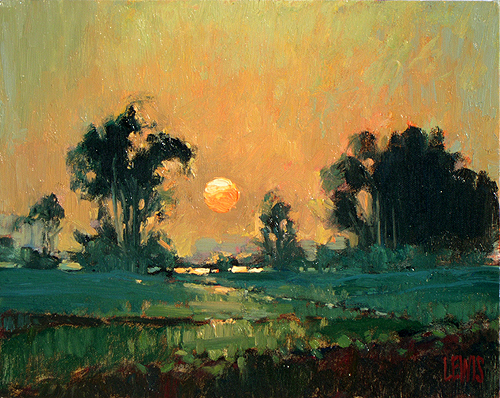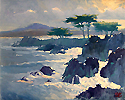| Below is the entire Plein Air Easton 2009 blog by Robert Lewis in chronological order.
Contents Day One: In Training |
[TOP]
Day One: In Training
| You’d think that getting your painting supplies to Maryland would be simple. And it is, if you are willing to spend, spend, spend!! I checked the American Airlines site early this morning to see what their baggage requirements…uh, or should I say, restrictions are…
Grrrr. I threw the bag into the car and drove down to UPS. Can you ship this as is, in this baggage? Yes, of course! How much? $75. So. I gave UPS the bag, and I also brought in the seven frames I had bubble-wrapped. I said pop these into a box and ship them too. Well, they had to make a box, and with the insurance everything, it came to about $200. But I don’t have to lug this stuff through the airport and I still save a couple hundred. Sometime next week, the two boxes will arrive at the home of my lovely hosts, the Hamiltons, near Easton, Maryland. |
[TOP]
Intending to Paint Boats, I Got Distracted

Setting out this morning nice and early with the idea of painting boats, I parked at the Coast Guard pier overlooking the Monterey Bay and the Monterey harbor. It is a bright and clear day. Immediately I am caught by this scene of the hotels on piers over the rocks and the water. Boats can wait. The pier is very busy with scuba divers in various degrees of dress, pulling on and pulling off their wet suits. The water is very cold in Monterey Bay. But the air was perfect this morning and I enjoyed the colorful reflections in the water below the buildings. After painting, I walked over to the other side of the pier where the is a boatyard. With my carpenter’s pencil and a ringed binder of sketch paper I drew several sketch of boats in dry dock, and searched for good locations to paint. Other than the boatyard, however, I think I will have better luck finding boat scenes across the harbor at the Fisherman’s Wharf and over at the other wharf, pier two. Some lucky boat will get its portrait painted tomorrow. |
[TOP]
Fear of Boats
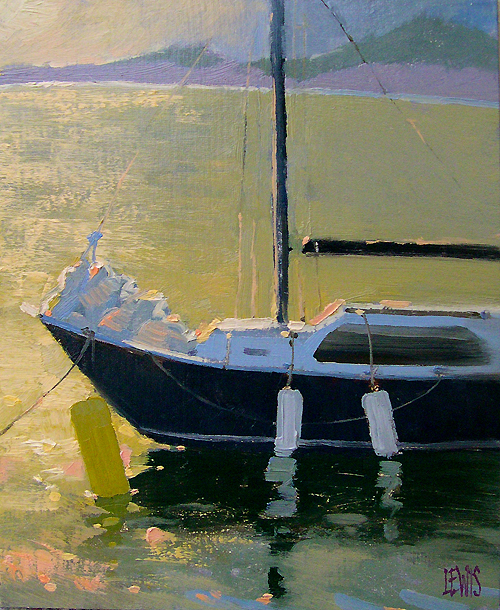 |
|
|
“Boat and Buoy”, 11″x14″ oil on canvas board by Robert Lewis
|
|
| This morning… | |
| The signs were not good. I drew back the curtain at 6am and saw gray clouds, not a hint of sun. Pacific Grove is known for fog so low hanging clouds is a good day…but not for painting. One of my rules is never to paint when it is overcast. However, this is training, training for a competition, and anything can happen in a competition. So the overcast rule is void. Anyway, I was looking for boats and all the boats are over the hill in Monterey. So often one drives over the hill and comes out of the fog into a silvery morning light, sparkling on the water and the boats. Though I held this vision in my mind like a grail, part of me was laughing, you fool! That’s because there was something about these clouds that told me Monterey would be cloudy too. I was right.
Early enough to park on pier 2 without feeding the meter, I set up my easel alongside the railing with a view to the east and a single boat. My spirits as gray and languid as the sky and water, I began the routine of laying out the palette and blocking in the shapes…uh…shape. One boat. And far away too. Too far, really, to paint it without a telescope. I’d forgotten my telescope! Everything went wrong, and had gone wrong from the beginning so midway through the painting I realized it would be a disaster, the painting would never be any good at all, ever. I’d broken every rule and what would happen is I would spend the rest of the painting trying to fix it! My other rule: when you realize you’re going to spend the whole time fixing the painting instead of painting the painting, get the palette knife out and scrape the canvas. With all my heart, I honored this rule, glad that I was finally doing something right. Also, I decided that the boat was too far away and that I’d need to use my eyes like a telescope and zoom in closer so that I could see details in the painting. Breaking the first rule of never painting when it was overcast made me realize that I had to paint in the sunlight even though I didn’t actually see it at that moment. By the time I would be nearly done with this painting the sun would have broken through and I could make a fair guess at how that would look. Best of all, I used my ace in the whole rule that says, solve any problem using artistic license. After all, you are an artist and you are temperamental (even if you aren’t; people believe you are, so might as well be!) put the sun in and full steam ahead. Using this nautical metaphor as my guide, I was finally on a good course, headin’ for port, arrrr…I could go on with these boat references but I won’t because, as you see, I have finally lost my fear and embraced my inner boat. An odd thing happened that proves my good fortune and there is a photo to prove it. At one point in this painting there suddenly appeared several tiny dots of white, no larger that the head of a pin, all over the canvas. Could it be a little bit of mist or rain had hit the canvas and turned the oil paint white. Not likely. I stood there pondering this mystery for a minute, then I looked over at my car and saw an astounding sight. It was completely speckled head to toe, front to back with a vast splattering of avian rain, manna from bird heaven, celestial poop, the most bird droppings I’ve ever seen in one place. Only my car was spattered, none of the others. Just that bit of bird poop mist on my canvas. I marveled at the odds of it coming so close and missing me, and I was thankful I had dodged a whole box of bullets. What I’m going to say now has nothing to do with the art of painting, but perhaps it does have something to do with the art of competing or, at least, being able to concentrate: Sometime I will have to talk about all of the annoying things that can happen while you are painting, such as the group of men who were fishing nearby. One of them laughed hysterically for 2 1/2 hours. I’m glad he was happy but I couldn’t hear what they were talking about, all I could hear was what came to sound like a maniac cackling away. Or, the guy who came up and stood too close for a minute, looking at my boat painting, finally asking “What are you painting?” I mean, what do say to a question like that? |
|
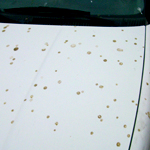
Above, the hood of my car shortly after the mysterious shower. |
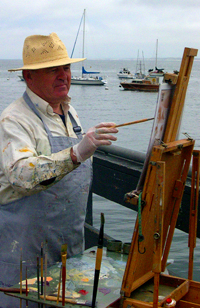 |
| Later, that afternoon… | |
| It was my turn to sit my gallery today, a little one-room gallery in downtown Pacific Grove. Not much, but rather nice. I’ve had it for six years now. Having promised myself to paint two paintings today, like you might do in a competition, remember this is training, I set up my easel outside the gallery on the street. It’s not a bad view because looking down the street you can see the Monterey Bay. Oh, I forgot to tell you, it is sunny now…in Pacific Grove.
It’s funny how you can see a scene a thousand times and never really see it. Such was my experience today. For this little town, it is a rather ordinary scene, but there in the tree was a Chinese lantern, hung there because of an upcoming festival, inexplicably called the Feast of Lanterns. It is true there are a lot of lanterns, but not much feasting. Painting on the street like this is an invitation for more comments that rub you the wrong way. Actually, I came to a realization about myself today, I’m really a grumpy, unfriendly person. For example, when someone comes up to me while I am painting and says “Oh, you look so peaceful.” what they don’t know is that I am so very close to biting their head off. Or, “What are you painting?” Again! My friend Jeff Daniel Smith, a wonderful painter, came by and we traded stories like this for half an hour, concluded that both of us are either getting old and impatient or are just intolerant people. I was almost convinced but prefer to think people just ask dumb questions. But, I don’t blame them, so don’t get me wrong. People are just trying to connect, and that’s really very nice. What else should they say?! (How ’bout nothing?) The tree leans over against the building in this painting and creates a tunnel, at the end of which is lots of light and the bay. But before you can go there, the red lantern stops you. |
|
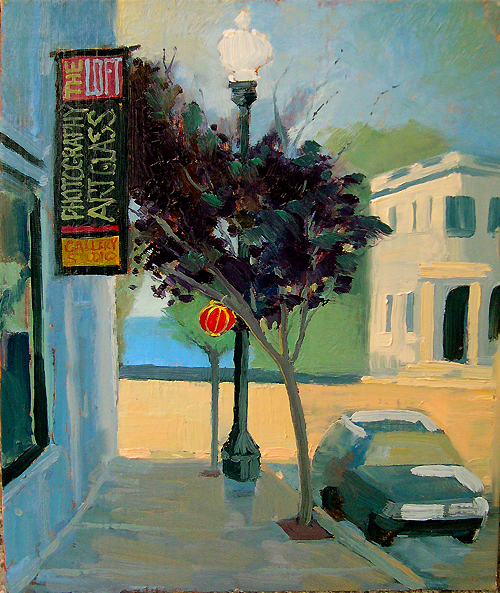 |
|
| “Chinese Lantern”, 9″x12″ oil on canvas board by Robert Lewis | |
[TOP]
Escape from the Fog
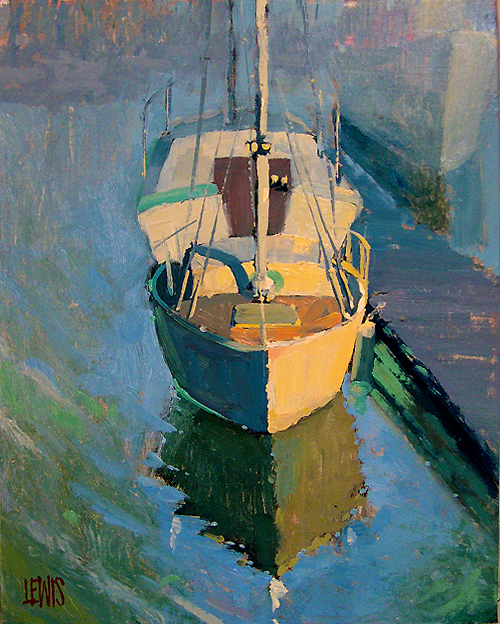 |
|
“Boats at Moss Landing “, 11″x14″ oil on canvas board by Robert Lewis
|
| At 6am I looked out my window at the garden and the garden wasn’t there. It’s only 20 feet away but it was gone. Fog had rolled in, a thick garden-eating fog that lay up against my window breathing hard, trying to find a way in to get me. I pulled the curtains quickly, turned in panic, thinking about painting. I can’t paint in the fog, my mind screamed! Then I remembered. I had made plans to go to Moss Landing today. Moss Landing, where I believed, with an unshakeable faith, that the sun would be shining, and not only would it be shining but it would be shining on…boats! I calmed myself with this beautiful image of sparkly white boated, clanging rigging, and the calls of gulls.
Picking up ol’ Dad, who wanted to go along and see the old marina where, years ago, he once kept a small boat, we stopped for coffee to go and made our way through the fog and overcast north, skirting the Monterey bay. We traveled through farmlands and had a lively discussion about the farm workers bent over harvesting our dinner, agreeing once and for all that they are hard working, have a shot at a good life and are taking it. God bless them! But Dad became gloomy about the weather, the overcast and the fog, grumbling that I probably would not get the sun I needed. Look up ahead, I said, what do you see? A glowing spot in the fog. Moss Landing! After scouting out the harbor, which is filled with raggedy old boats and research vessels, we picked a spot and I started painting. This training has been good for me, though grueling. Pushing hard has revealed all of my weaknesses in mind, body, spirit and painting ability. I am very sad to say that there are too many weaknesses and I was a happier person when I was not so fully aware of my weaknesses! But, one must push on with what one has, trying to learn, to overcome, and, in this case, paint better. My competition will easily see that I am not much competition after all. Especially if I keep making the same mistakes over and over again. In the case of this painting, I like how I’ve captured the light and the reflection, but why why why did I pull back so far from it! It was my intent to fill the canvas with the boat. Yet, when I was finished, there it is, a small part of a large expanse of uninteresting water. Some kind of mnemonic device is needed to make me remember to fill the canvas with the subject. This painting would have been better had I reminded myself that everyone knows a boat floats on water, no need to prove it by showing the entire harbor. That’s what training is all about. Of course, not just training but learning how to paint better. Given all of the distractions and variables perhaps it is a miracle of sorts that anything half way decent comes of this. |
| Back to the (brain) Fog… |
| After this tough morning, I dropped Dad off at the Fisherman’s Wharf and drove home and lay down, sunburned, eyes tired, and feet sore. Rain had washed the fog away. I could see the garden again. Falling into a fitful sleep, I dreamed a jumble of vivid image all somehow connected with boats and painting. If you’ve ever seen a dog sleeping and it looks like he’s dreaming about chasing a rabbit, his paws moving in little running movements, low half-barks coming out of him, anyone watching me sleep would have seen something similar. But I would be making brushstroke and palette knife movements and grumbling half-curses. When I woke up I couldn’t imagine ever painting again, in my life. Death. Nap death. You know how that feels…
But I got up. And I drove back over to Monterey and set up near the little boatyard that is next to Del Monte beach near the entrance to pier 2, where I had painted the other day and missed the seagull bombardment. Thinking that I would do a sketch only, an oil sketch, I stood there painting, still half asleep, mumbling over and over “Sketch….sketch…just a sketch…”. It is Saturday and the beach is filled with a thousand happy, barbeque-ing, beer-drinking people with children shrieking, leaping in the water and chasing each other. A very, very happy and noisy scene. Forlorn that they were having fun and I was working, I faced yet another challenge of plein air painting: leisure envy. But I got over it, was happy for them, and proud of myself for overcoming the Very Strong Urge, as Pooh would say, of blowing off the day and just having a beer like any normal person would do! But I came to my senses with the certain realization that I am not normal so I would be going against my nature to actually relax and have fun! But I am just wallowing in self-pity now. Perhaps, the high point of this painting was when a man walked up to me, about to ask a dumb question, and me turning to hear for the hundredth time “What are you painting?” when he used a word I had never heard used before: orthogonally. Because the sun was behind me (another of my rules broken!) I had turned my easel at a right angle to the scene I was painting so that the sun would not fall on the canvas. “Excuse me”, he said very politely, “I couldn’t help notice you are painting orthogonally to the scene and I was just wondering if you could tell me why.” I liked him right away. An original question. Funny thing is, I knew what he meant, though it struck me that I had never actually heard anyone say that word. The nice thing about this painting is the the full sun is pummeling the dusty ground and the light is bouncing up on the bottoms of the boats. Orthogonal or not, however, I insist it is just a sketch. |
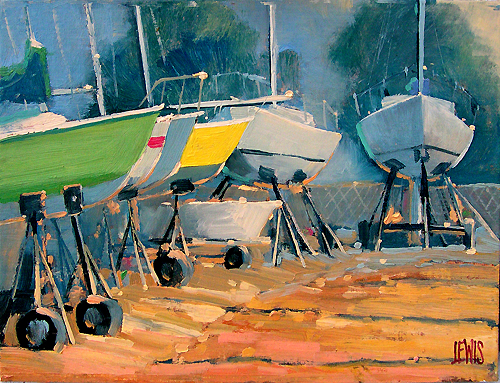 |
| “Del Monte Beach Boatyard “, 12 “x9” oil on canvas board by Robert Lewis |
[TOP]
Having My Way
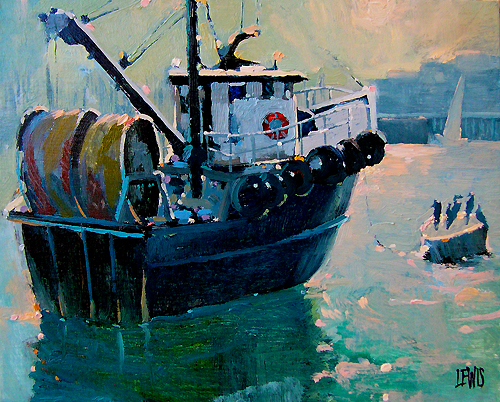 |
|
“Irene’s Way “, 11″x14″ oil on canvas board by Robert Lewis
|
| To say that I know how to paint boats would be a very big mistake. After five days of painting nothing else, thinking of nothing else, dreaming of nothing else, eating nothing else, I admit I’ve made progress. But my experience tells me over and over ( not that I ever learn! ) that the moment I feel smug enough to say I’ve made a breakthrough, Plein Air bites me hard. Meaning that tomorrow’s painting may be a complete disaster. So, I will be coy in my assessment of this painting: While painting it, I had some good moments. Looking at the finished piece, I can say it has its good points.
Clearly, however, I am miles way from the shore I want to stand upon. Don’t get me started on nautical metaphors again. This morning I felt that my bad attitude about the questions that people ask is really wrong. As a plein air painter, you have inserted yourself into the landscape in the most unusual way. To the person strolling by you are as out of place as a beautiful model in a formal gown with a film crew, or a crazy clown blowing balloons, or a mime! Oh. This is a very disturbing thought. I wish I hadn’t thought of it. But it is true in a way. Then there is the other aspect of the average person as an art critic. Generally, people don’t know a thing about art but “they know what they like”. So, even though you may be bewailing the failed painting you are trying to complete, and someone gives you the thumbs up, and you are tempted to show them a different digit, remember (and I’m speaking to myself here.) be kind. Just say “Thank you.” By the way, there are two kinds of boats, those that are docked and those that are moored. Boats that are moored have this annoying habit of moving. Just as your chosen boat is turned just so, looking all interesting and beautiful, and you start to paint it, you will find that when you look up, it is turned completely around facing a different direction. Of course, no worry, it will come back to the beginning again in some mysterious cycle of profiles it displays to you as if to say aren’t I the prettiest boat you’ve ever seen? I can’t say that Irene’s Way is one of the prettiest, but it is certainly the largest boat in the Monterey harbor. It has a dark presence, and is moored alone in a large area so it can show us all of its sides. Why Irene’s Way? I can’t begin to speculate on that, except to say that if Irene was anything like this boat, she most certainly got her way. |
[TOP]
PAIN-ting Lessons
 I am psychic. My prediction of yesterday came true. More on that later in this post. A few thoughts first… I am psychic. My prediction of yesterday came true. More on that later in this post. A few thoughts first…
Let me make this clear, I am not an expert on plein air painting. But I am an expert on my experience of plein air painting. So I proceed with this blog knowing that what I say is inherently flawed and inadequate, that some artists will wonder what all the fuss is about, that some of my realizations are common knowledge and self-evident to a smarter person so what’s the big deal, and I’ve got a lot of gall to put myself out there. All true, all very true. Nevertheless, for whatever reason I began painting plein air more than 10 years ago, it is equally true that I have gained some experience and thoughts that might be useful This sketchbook photo is a reminder —and a recommendation. Two years prior to painting plein air for the first time, I put away all of my art supplies and bought a sketchbook with large rings. This was to make it easy to open flat. At the hardware store, I bought a carpenter’s pencil, broad and flat; it won’t roll and it inhibits one from getting too detailed. The beautiful landscape is one thing to behold and, no matter how familiar you are with it, another thing to draw. I knew this instinctively, so I determined that before I would paint a single stroke, I would learn to draw the landscape, to quickly apprehend the forms, to edit on the fly, to practice not getting hung up on details but find the essence of the composition before me. I would go back to basics: pencil and paper. This sketchbook, and a series of perhaps ten more, accompanied me everywhere, every day, and I made it a habit to sketch everything I saw. After two years of this, the day finally came when I was sick of sketching and knew it was time to paint. I rarely sketched after that, preferring to “sketch” with a brush directly on the canvas. Recently, circumstances and my own frustrations have reminded me of this simple, powerful discipline. As soon as I began carrying my sketchbook again and sketching the composition just prior to painting it, my paintings have improved. So, the recommendation is: sketch. Keep it an ongoing practice and don’t allow yourself to be fooled into thinking you don’t need to practice sketching anymore. |
| Easel Rider |
 There are so many kinds of easels. I think I’ve tried them all. The common French easel has an inherent flaw in the way it holds canvases. Very quickly and early on, I came up with a trick that I want to share: rubber bands. I use rubber bands and a couple of flat sticks to create a pressure mounting that holds your canvas in place and prevents it from slipping out when you are carrying the folded easel with the wet painting in place. There are so many kinds of easels. I think I’ve tried them all. The common French easel has an inherent flaw in the way it holds canvases. Very quickly and early on, I came up with a trick that I want to share: rubber bands. I use rubber bands and a couple of flat sticks to create a pressure mounting that holds your canvas in place and prevents it from slipping out when you are carrying the folded easel with the wet painting in place.
You will place the pressure mounts in the top and the bottom canvas “grooves”. Take a look at the photos. A stick is wrapped every couple of inches with a rubber band, then the prepared stick is inserted into the groove and held in place with more rubber bands. Set your canvas in place and tighten it down. Rather than the canvas relying on hard, unyielding wood, the rubber presses snugly against the canvas holding it firmly in place even when you are moving. You will need to replace the rubber bands after several weeks as it deteriorates. |
  |
| Beware of Pretty… |
| I told you I was psychic. Yesterday I tried to be coy in my assessment about the boat painting and predicted that, if I were not humble, my experience told me that the next day would be a painting disaster. It tried to be coy but wasn’t really. I skirted the edges of humility only, and today I paid the price, fulfilling my own prediction.
Waking up rather late and with little energy, clearly burnt out on this crazy pace, I was led to the Carmel Mission near Carmel-by-the-Sea, California. It is only a few miles away. When I woke up, I saw the mission in my mind and took that to mean I should go there. I know enough now that this doesn’t mean that I will paint well in the places I am led to, but that I have, at least, something to learn. You would think that painting something as quaint, picturesque as a California mission would be easy. However, what I learned today will definitely be added to my growing set of Lewis’ Laws: Be wary of picturesque scenes. I must emphasize, now that I look back over many experiences like this, be very wary! There is something almost diabolical about the seduction of these scenes. They are just too pat, to pretty. And, worse yet, they play on your weakness. They say, oh, I can sell this painting, everyone likes a mission painting. Don’t get me wrong, I like to sell as much as the next artist, but if that evil thought enters your mind you have gone down a bad path; you should back up, get out, and run. This is not to say that one shouldn’t paint picturesque, postcard scenes, but they must be painted in a very different frame of mind than the usual scene. Forgive this example if it offends anyone, but I think it works to illustrate what I mean: if the scene can be compared to a very beautiful woman who also happens to have a brilliant mind, what would you paint? Only the obvious beauty? Of course not. You must also find a way to convey her intelligence, otherwise it’s just another painting of a pretty woman, and you’ve failed as an artist and become a hack. I can see now that painting a postcard scene should be approached in the same manner. One must look beyond the obvious and find, and convey, the inner intelligence of the scene. Having finished the painting of the mission, and failing to convey anything of its spirit, I scraped it off. |
[TOP]
Desiderata
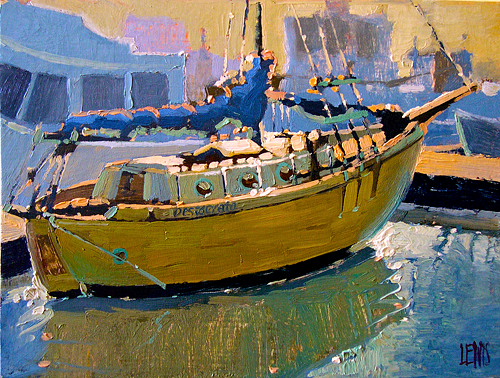 |
| “Go placidly amid the noise and the haste, and remember what peace there may be in silence.” — from Desiderata by Max Ehrmann (1872–1945) |
| What’s in a Boat Name? |
| This morning there was no fog, no hint of cloud, and I could see, in my mind’s eye, the harbor in Moss Landing. It was filled with sunlight and happy boats. There was no hesitation, no doubt in my mind, I was peaceful and secure in this image. I quietly finished my tea, packed a lunch, and headed out, leaving the peninsula behind and skirted around the bay through morning farmlands again. I pulled into the harbor an hour later. Sun, glorious sun. And quiet, no sound of gulls, no barking of sea lions. The day was still new, at that sweet spot between the last of sleep and the first of work, that spot where it is possible to feel happy to have made it one more day and have one more chance.
The naming of a boat is one of those areas of human creativity where the average person becomes his most creatively outlandish. Boat names seem to reflect something very personal. They speak, perhaps, of long lost loves or wives at home, like Miss Annie, Celeste, Valerie, and Miss Annie. They speak of saucy ladies whose identities should be protected, like Rachel T., Jeanne B., or Catarina B. I wondered who they are, and realized that if I had a saucy lady boat it would probably be Mae W. Other boat names are wistful, wishful, and dreamy. They sing of the sea: Sea Wind, Midnight Flyer, Dreamcatcher, Night Wind, Ocean Angel. Still others portray the cap’n and crew as salty sea dudes: Desperado, Greybeard, Outrider, and Shelter Dog. There is a smattering of non-English names, Pancho, La Muchacha, and the Happy Tortilla, or, further abroad, Andiamo, Anam Cara, and even Brillig. Some are just odd. You can’t help but wonder why, why, Chicken o’ the Sea. Or Krusty Krab 2: that means there have been two Krusty Krabs. Most original: Onchorynchus; guess what the captain does. There are the obvious ones like Bob-a-Lou, Hook Up, and Tina Louise; it’s clear what they were thinking. As I explored the harbor looking for a boat to paint, looking for the right angle, the right interest, some color, I came around the corner and my eyes fell upon a yellow boat, Desiderata. Perhaps I have a thing for yellow boats; second one this week. But it was a combination of the yellow and the name. Desiderata’s home port is London, by the way, but it looks as if it has been sitting in this slip for some time now Odd, the name Desiderata, things desired, and the beginning line “Go placidly amid the noise and haste….” perfectly matched my mood. In plein air painting, this is what I look for, this flowing back and forth between me and the landscape I am in. It speaks, I respond. I respond, it speaks. When this happens, it takes my breath away and, still learning, it makes me nervous. Nervous because I see, without any doubt, this is what I was meant to paint and so now it is up to me to rise to the occasion. In that spirit, I rose and painted “Desiderata”, 12″x9″ oil on canvas board. |
[TOP]
Lucidity, Thucydides, Lucidity
[TOP]
Magical Helpers
[TOP]
Day One at Plein Air Easton
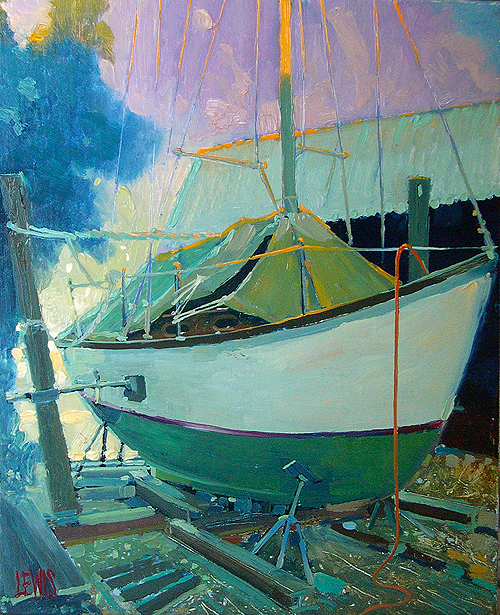 |
| “Every obstacle yields to stern resolve. He who is fixed to a star does not change his mind.“ — Leonardo da Vinci |
| The painting you see here is the first painting I did in this year’s Plein Air Easton painting competition. It is “Cutts & Case Boat Yard”, 11″x14″ oil on canvas board. As usual, it is the best of the collection I put together in four days. Nine paintings in four days. It always seems that the first one I do is the best. But it was a good idea that I had scouted the location on the prior day, and got there early. My energy was good compared to later in the week when I became increasingly ill and had to call my doctor on the West coast. Illness, however, is yet another of the plein air challenges. One learns to work with it, in it, and around it. The obstacle of illness, like any other obstacle, is an opportunity to grow in your resolve, digging very deep to find your inner resources.
Last night, I turned in all of my paintings with the help of another magical helper, Steven, Susan Ploughe’s husband. On walking into the museum to drop off the paintings, we were immediately faced with two magnificent Tim Bell paintings. Bell is just a wonderful painter. He is a rough and tumble Maryland ex-marine who knows skipjacks like no one else. A young master now, I can not imagine how great he will be when he is an old man. Paintings turned in and back at the home of the Hamiltons, my delightful and generous hosts, I slept deep, on the mend. Today is a day off of painting. I am sitting on a sun porch. From this view I can see the Chesapeake bay just on the other side of a stretch of lush gardens, a pool, gazebo, and long lawn. In the background, Christie’s chickens are squawking and the geese are fussing about something. The air is filled with birdsong, sun, and peace. If I am not a blessed person, then no one is. Tonight is the collector’s show. At six o’clock the doors will open and we will see who are the award winners. The collectors will come in, having paid $150 for the privilege, and the buying will begin. The show is open to the general public tomorrow. Having pushed through and beyond all obstacles, for the moment, and for the next few hours, I will lounge, nap, and give thanks in this sparkling landscape of wonderful people, water, cicada, birds, sheep, cornfields…and boats! |
[TOP]
Let Nothing Stop You
| On day two of the Plein Air Easton painting competition, I woke up feeling ill. The ear infection that had gotten me down had not responded to the antibiotics and I felt worse. Getting out of bed seemed a great accomplishment. This was bad. Picking up the phone, I called my doctor on the West coast, in Carmel, California. I left a message, begging him to call in a refill to the antibiotics at a local pharmacy. I left the number for it.
After a cup of tea and a bowl of oatmeal, I was nearly human again. At least, I passed for human. No one would ever know I was really the walking dead. Looming over the entire scene is a Chesapeake lighthouse, a very peculiar six-sided structure on stilts that is both odd and beautiful. The day was dark, no sun on the horizon, only gray clouds in every shade of gray known to an artist. To say that I broke my first rule, never paint when it is overcast, would be an understatement. This is a competition and plein air painters are more trustworthy than a postman. Nothing will stop us, not ear infections, dog and bug bites, bee stings, broken easels, aches and pains, cloudy days…or stupid rules! So, add to my list of Lewis’ Laws of plein air painting: Let nothing stop you. So it was time to make lemonade with the lemons given me. But I complain too much, because right in front of me, as I peered over the shoulders of at least two other painters who were also trying to make lemonade, was my prize, the lighthouse. Now normally I might not have painted a lighthouse being that painting a lighthouse is dangerously close to breaking that other Lewis Law, Beware of pretty . This was not, however, pretty. This was dark, foreboding but with a saving grace in that there were two porch lights still on, one on either side of the lighthouse. Plus the lighthouse was actually a working lighthouse and its brilliant light flicked a ray of happiness into the glooming sky. Together, the three lights looked like Christmas to me, a bright spot in a long dark winter. By the time I had finished this moody painting, the sky had cleared to a great extent and sun was beginning to flood the scene. I rested, called the pharmacy to see if the doctor had called in the prescription yet. No. So I called his office on the West coast again, explained the situation and noted to them that it was only a phone call I was asking. Nearby, one of the painters was giving up on his rendition of a skipjack, a beautiful old beauty of a boat, once used for oystering. Personally, his painting took my breath away but he was very unhappy with it. I thought it was a winner and so I tried to convince him to scrap it. (Just kidding, of course.) But he didn’t fall for my trick. He did give up the perfect spot, just the right angle to paint the boat. It’s funny how an artist can find the exact right place to paint from. No other angle of this boat would do and so I was happy that he had given me the spot. With his laments still ringing in my tortured ears, I went at this painting differently. Painting fast and loose and taking great liberties with color, I finished a rather successful take on a skipjack. Or, so I thought. I was standing there congratulating myself on having finally painted a famed skipjack, legendary boat of the Chesapeake Bay. I swear, no sooner had I thought this thought when an old man stepped up beside me, and in a voice that was all salty and straw sticking out of the mouth he says “Yep. That’s a bugeye, alright.” A bugeye! Not a skipjack? Nope. That’s a bugeye. Skipjack’s only got one mast. That’n’s got two. I was very disappointed but, more than that, mystified. Tell me, how did he know that I was thinking, at that very moment , that I had just painted a skipjack? Someday I will paint a skipjack, but not this time. Meanwhile, in the back of my mind, I was thinking about two things: the prescription, and the sunset painting that was forming in my head. Just then the cell rings and it is my doctor. He’s just called in the prescription and best of luck, see you when you get back. I left St. Michael’s for Easton, a 15 minute drive, to pick up the RX. Timing is so important in life, and so it is in plein air painting, particularly when you are competing. After picking up the prescription and taking the medicine and feeling a sense of optimism, the timing was perfect to leave for Campbell’s boat yard in Oxford where, the day before I had painted and seen the potential sunset. The timing was perfect for blocking in the painting and waiting for the sun to lower into place right where I hoped it would, tucked neatly between two dry-docked sailing boats. At the boat yard, the owner of one of the about to be immortalized boats was working on his hole in the water where you throw money. I could see that he knew the place well. I had no doubt that he could answer my question “Where, exactly, will the sun set tonight?” He pointed to the roof of a boat house on the other side of the harbor. Right there. Now, I was also proud of myself because, though the sun was still quite high, I had estimated that exact spot too. Even better, in the morning, when it was wet and gray gloomy, I had told one of the depressed artists that by the end of the day it would be clear and there will be a good sunset. It did seem doubtful at the time. This morning, when I saw the same artist, he said “What, are you some kind of psychic artist, or something?!” Or something. The sun dropped into place as I and the boat owner had known it would. Not long after that, I was home in a deep, hard sleep. Nothing could stop me. |
[TOP]
Fixed on a Star
| “ Every obstacle yields to stern resolve. He who is fixed to a star does not change his mind. “ — Leonardo da Vinci |
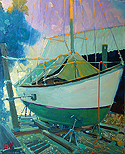 The painting you see here is the first painting I did in this year’s Plein Air Easton painting competition. It is “Cutts & Case Boat Yard” , 11?x14? oil on canvas board. As usual, it is the best of the collection I put together in four days. Nine paintings in four days. It always seems that the first one I do is the best. But it was a good idea that I had scouted the location on the prior day, and got there early. My energy was good compared to later in the week when I became increasingly ill and had to call my doctor on the West coast. Illness, however, is yet another of the plein air challenges. One learns to work with it, in it, and around it. The obstacle of illness, like any other obstacle, is an opportunity to grow in your resolve, digging very deep to find your inner resources. The painting you see here is the first painting I did in this year’s Plein Air Easton painting competition. It is “Cutts & Case Boat Yard” , 11?x14? oil on canvas board. As usual, it is the best of the collection I put together in four days. Nine paintings in four days. It always seems that the first one I do is the best. But it was a good idea that I had scouted the location on the prior day, and got there early. My energy was good compared to later in the week when I became increasingly ill and had to call my doctor on the West coast. Illness, however, is yet another of the plein air challenges. One learns to work with it, in it, and around it. The obstacle of illness, like any other obstacle, is an opportunity to grow in your resolve, digging very deep to find your inner resources.
Last night, I turned in all of my paintings with the help of another magical helper, Steven, Susan Ploughe’s husband. On walking into the museum to drop off the paintings, we were immediately faced with two magnificent Tim Bell paintings. Bell is just a wonderful painter. He is a rough and tumble Maryland ex-marine who knows skipjacks like no one else. A young master now, I can not imagine how great he will be when he is an old man. Having left the common world for the world of magic and striving, having battled the demons of self and environment, having faced artistic and physical obstacles and challenges, and having brought back the boon, I rest now, a bit battered, with a sense of accomplishment if nothing else. So, my paintings turned in, back at the home of the Hamiltons, my delightful and generous hosts, I slept deeply, on the mend. Today is a day off of painting. I am sitting on a sun porch. From this view I can see the Chesapeake bay just on the other side of a stretch of lush gardens, a pool, gazebo, and long lawn. In the background, Christie’s chickens are squawking and the geese are fussing about something. The air is filled with birdsong, sun, and peace. If I am not a blessed person, then no one is. Tonight is the collector’s show. At six o’clock the doors will open and we will see who are the award winners. The collectors will come in, having paid $150 for the privilege, and the buying will begin. The show is open to the general public tomorrow. Having pushed through and beyond all obstacles, for the moment, and for the next few hours, I will lounge, nap, and give thanks in this sparkling landscape of wonderful people, water, cicada, birds, sheep, cornfields…and boats! |
[TOP]
Give It Everything You’ve Got
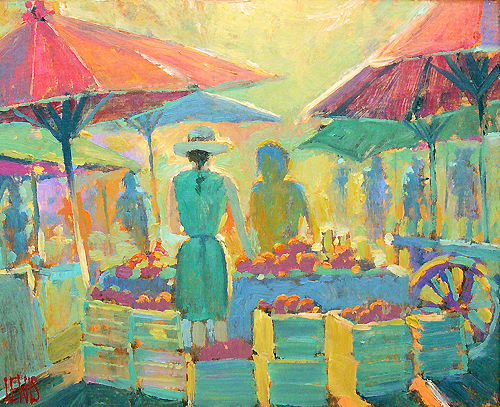 |
| ” No one understands that you have given everything. You must give more.“
— Antonio Porchia , Voces , 1943 |
| The Quick Draw is an event loved and hated by an artist. On the one hand, it only lasts two hours and often your painting sells. On the other, you only have two hours to paint a painting that is worthy of being purchased. On top of that add in some hot asphalt, direct sun, temps in the 90s, humidity, and hundreds of onlookers.
I learned much from my work this week and one thing was clear, people in a painting take a painting to a new level of interest and narrative. Ol’ Dad’s been telling me this for years and now I finally get it. So the message coming through to me was to paint people in my paintings, something I have almost never done. It is more accurate to say I have avoided painting people since my few efforts were mostly humorous. Resolving to paint people when I return home is, of course, the easy way out. I’ll do it later. Right. So at 10am I set up my easel in a scene that centered on people, plunging right in to what is for me a challenge. But there’s that word again: challenge. Fortunately, the farmer’s market was in full fruit and I scouted out and discovered this natural composition, fruit crates of peaches in a semi-circle around the seller, colorful umbrellas tipping this way and that like happy kites. At 10am, all the artists began painting, and there were probably two hundred of them scattered around the town of Easton. Any artist could pay his fee and enter. It was not restricted to the competitors of the Plein Air Easton competition. My approach was to paint fast and loose, to prevent myself from fussing over details or overworking the piece. I wanted to capture the lighthearted joy of this scene, the nice little peach stand, and the woman selling the peaches. A little girl, about 6, approached me and said “That’s my mommy!” I said, oh, what’s her name? She looked at me for a second and said, as if I were dense, “Mommy.” I later found out that Mommy had a first name, Linda. The painting is called “Sweet Peaches”, 14″x11″ oil on canvas board. Just before noon, I signed the piece. My friends George Hamilton and Steven Ploughe, Susan’s husband, came by to help me carry my gear back to Susan’s car where she had a frame for me. Susan was also painting in the Quick Draw. We all met at the car and framed our pieces quickly, slogged everything a few streets over to the street where all two hundred artist were setting up their easels for a street art show of the new paintings. Within moments both my piece and Susan’s piece were sold. Awards took place at two and we all cheered when Susan won Best Use of Light for her little garden painting. After a hard week of overcoming illness and fatigue and all of the other challenges of plein air painting, the Quick Draw is one more chance to step up and give it everything you’ve got and then give some more. Nothing like it. Tomorrow, the Sunday Brunch and the end of Plein Air Easton. |
[TOP]
Changing the Palette
 |
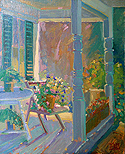 |
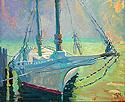 |
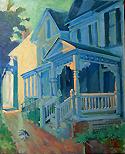 |
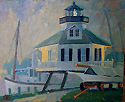 |
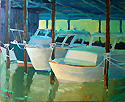 |
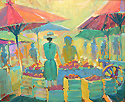 |
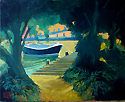 |
| I know this feeling and I don’t like it. It’s the same feeling I get whenever I arrive home after weeks in some exotic land. It was there when I returned from the intense color and sweat of Tahiti. It’s ungloved hand slapped me when I came back to the warmth from the blue ice of Antarctica , and the wild landscape of Iceland . In Paris , it lurked behind every cafe table, every pretty smile, every bright and sunny memory-to-be, awaiting my return to America before it struck with its chill accuracy. As a teen, it was there at the end of high school plays that took weeks to rehearse and a night or two to perform. And once again it has chased me, tackled me and brought me down hard after Plein Air Easton. It is the “let down”.
At first, it seems there is little we can do to fight this feeling; it has this overwhelming caste of inevitability about it. One arrives home, especially after exciting and energizing days, with this marvelous sense of the newness of life, our brains spinning, turning in circles with ideas, colors, plans, intentions. We plunge into our old situations vowing to change the things we don’t like and to turn our path toward the shining way we have glimpsed in our travels. The shining way…I still see it, don’t you? Part of us, having had this feeling before, takes precautions, takes the intitiative, makes pre-emptive strikes and forays into our new vision. We avoid old things, old habits. All the old routines seems like traps we must avoid, like quick sand that promises to suck us under and back down into the old world, tearing us sadly away from the new world we have seen, the new us we can envision and long for. We sleep on the other side of the bed, we change our diet, we stop using certain words, we, if we are artists, change our palette. It’s all about changing the palette, I think. Is there some nearly irresistable force that makes us go back to the things we are used to? What is this nasty habit of mind that drops us back so easily into what is familiar, leaving us with a sense that what we experienced while away was somehow unreal, something that is becoming hourly almost a sad and lost thing? Worse yet, a thing that happened yet happened to someone else , that other person we were when we were away… My week at Plein Air Easton was so utterly amazing and wonderful that I can hardly keep myself from shouting in joy. I am not exaggerating. As some of you know, I was ill most of the time. I arrived with a bad ear infection and it went down hill from there, to the point that I had to call my doctor back in California . In the first day or so I had moments when I thought it would be wiser to drop out. A smarter man would have, I’m sure. But I am not so smart as I am determined to overcome whatever I can overcome, and I am not so stupid to think that I can do this all on my own. A combination of beautiful things had to merge into an environment of support and encouragement, and it did merge something like what the new agers might call a “harmonic convergance”. The convergance I experienced had parts to it and each part was no greater or lesser than the next though I can only speak of them in some sort of sequence. First, my hosts, a dear and cheerful couple whose immense generousity was nearly impossible for me to believe; a failing of mine. They were not just willing hosts, they were deeply caring, interested, and interesting people who made me feel completely at home in their lovely estate, a beautiful pastoral paradise surrounded by sheep, chickens, geese, and elegant gardens flowing down to the Chesapeake shores. Secondly, the other guests in my hosts house, an accomplished artist and her husband who not only encouraged me but stepped up without hesitation when I needed help. I really can not convey the depth of my gratitude for these four people, fellow travelers in this great experience. Thirdly, the other artists who were at once friend, competitor, encourager, and hero. How often in life do we cheer each other on, take joy in the achievements of those we compete against, and value our time with each other? Is this not the real purpose of our lives? The fourth and last part of this convergance is that really unusual band of hearty soldiers, the workers, the volunteers and organizers who, along with friends and artists, made Plein Air Easton one of those wonderous forays into that other world of creative heroism, dynamic determination, and success. Each of us artists had our magical helpers, the hosts, the friends, the volunteers and organizers, the other artists. We fought well, so did they, and together we brought back a large body of work, the boon to mankind, for all to see. It is any wonder that returning to ordinary life can be a let down? For me, I can only keep fighting, switch things around, mix it up, change the palette, change the medium, sleep on the other side of the bed, anything and everything, to savor what I experienced and embed it into my being…until next year. |
|||
|
The End
|
|||


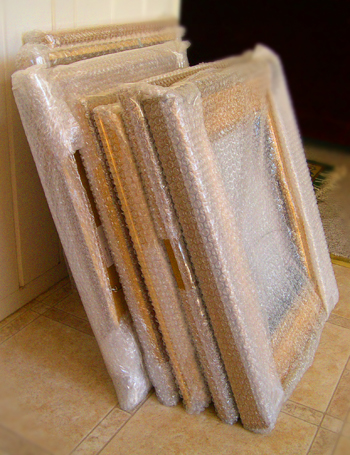 Here is a photo (right) of the wonderful thrift shop luggage I purchased for $5. I scaled all of my painting supplies down to fit into this bag. Half box French easel, wet canvas board carrier, and tool box full of paint and medium, plus my hat and a roll of paper towels for the first day of painting.
Here is a photo (right) of the wonderful thrift shop luggage I purchased for $5. I scaled all of my painting supplies down to fit into this bag. Half box French easel, wet canvas board carrier, and tool box full of paint and medium, plus my hat and a roll of paper towels for the first day of painting.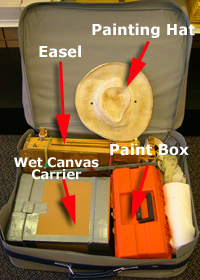 But this morning, American Airlines taught me how to measure my bag: width, plus length, plus depth equals a number. If that number were 62 inches or less then I’m okay. If not, the bag charge would be AT LEAST $150! Do you understand? That’s the cost for checking this bag! My bag totalled 64 inches. I was looking at more than $150.
But this morning, American Airlines taught me how to measure my bag: width, plus length, plus depth equals a number. If that number were 62 inches or less then I’m okay. If not, the bag charge would be AT LEAST $150! Do you understand? That’s the cost for checking this bag! My bag totalled 64 inches. I was looking at more than $150.
